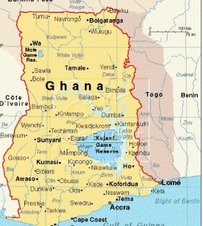When I first read that Kumasi was the cultural center of Ghana I was not certain what was meant by that. It never ceases to amaze me the value of experience and being an eye-witness.
Here in Kumasi, we have dedicated all of our formal activity to experiencing first hand some of the cultural richness of the Asante region. The Asante region of which Kumasi is the capital is also the center of the Akan civilization that I talked about many blog entries ago.
I will spend the first part of this post talking about three more craft visits we have made. In the last blog I already referred to the talented bronze worker. In our travels we have seen many of the bronze pieces available for sale. Our next visit on Monday morning was to a village called Pankronu where women control the pottery industry. A very old woman whose name I did not get danced and pranced around while she explained to us (with and interpreter) her craft. Actually, she and three other women whipped up from molds of clay about five different pieces in the space of about 20 minutes. We were sitting in plastic chairs in the middle of the village watching as other potters sat around and watched. We were exposed to a little drama when another potter arrived late and she was fussing at the others because they hadn't called her. It was funny to see the others scold her for her rude behavior as the show went on. After putting down their pieces so they could dry (in the misty rain) our host explained the process to us. In our question and answer session it was revealed to us that only women worked in pottery. In fact because the women went to the clay pits topless (because of the mess I'm sure) a man would be looked on very badly if he was anywhere around when women were gathering clay. It then started to rain harder so we went inside our host's house and she continued answering questions. The most interesting thing I learned here was that they didn't fire their works until they had about 1000 of them. And then they hauled them all to the outskirts of town where they made a huge fire and cooked the pieces there. When they were the most successful, the word would spread that the women of Pankronu were firing their pots and buyers would show up and buy them straight from the fire. The ones that didn't sell were transported back to the village by the women who made them. As we prepared to leave all of the potters who visited us boarded our bus to shake our hands one more time. Of course, our hoist danced her way through. These women were a pleasure to see.
Our next stop was in the village of Ahwiaa the home of the tradition of stool carving. These craftsmen used a variety of axes, knives, and forges to create some of the most beautiful stools I have ever seen. I was surprised to learn that for the men they shape the seats with a round shape while the stools for women are flat across the top. They make the benches out of hardwoods like teak, mahogany, cedar, and sese. Sese is the most durable wood and they make the most important benches out of it. For instance if a new Asantahene (king) was enstolled) they would make his new stool from sese. The tools these artists used were long and awkward looking to me, but these guys handled them with the greatest of skill. When we were turned loose to browse amongst the various shops of stools and other pieces made from wood, I was moved by the quality and made three purchases which will be very interesting to show students. One piece was a stool with the Sankofa symbol. The Sankofa is a bird that looks to his own back, and means that it is always permissible to go back and fix things you didn't quite get right the first time. The stool is a dark brown and is simply beautiful. I also bought a mask which is pretty simple in design. I think it is the simplicity which makes it so beautiful. And my final piece I bought was a sculpture that represents three movable people carved from one piece of wood. It is called unity. Family, community, and unity are revered here as qualities of life way more important than wealth. It is actually quite refreshing.
We then ate lunch and went to Ntonso to meet Percy Anquah who specialized in the making of Adinkra cloth. The adinkra process is where cloth is decorated by the use of stamps which have proverbial meanings. The artists skill was excellent as he created beautiful cloth almost without effort. This was a particularly even more fun stop for us because we all got to make a small piece for ourselves. For my two little squares I chose the crescent which means faithfulness and this design that represents a crocodile and the saying that goes with it is the crocodile lives in the water but breathes the air. It is a symbol that stresses the importance of adaptability. A common misconception of many people in the west is that Africans practice animism, but the truth is they simply use animals to depict the behavior of everyday people. The proverbs are very interesting.
We also visited the village of Bonwire to see how Kente cloth was made. The weavers who are traditionally male, but now a few women to practice it, are very talented. The demonstration they gave was extraordinarily brief. I am sure they just wanted to sell their works to this "group of Americans" who were ready to buy. The selling techniques of the artists was much to high pressure for me so I didn't purchase anything. The talent of making kente cloth traditionally comes from carefully watching a spider weave his web. It is a fantastic skill and the designs on the cloth tell a story much like that of the adinkra.
I have a surprise for you as I am trying to prod my traveling companions to post a blog. The first one willing to do so is Susan Parker, a 38 year teaching veteran from Fayetteville, North Carolina. The posting after this one is from Susan.
Wednesday, August 1, 2007
Subscribe to:
Posts (Atom)




